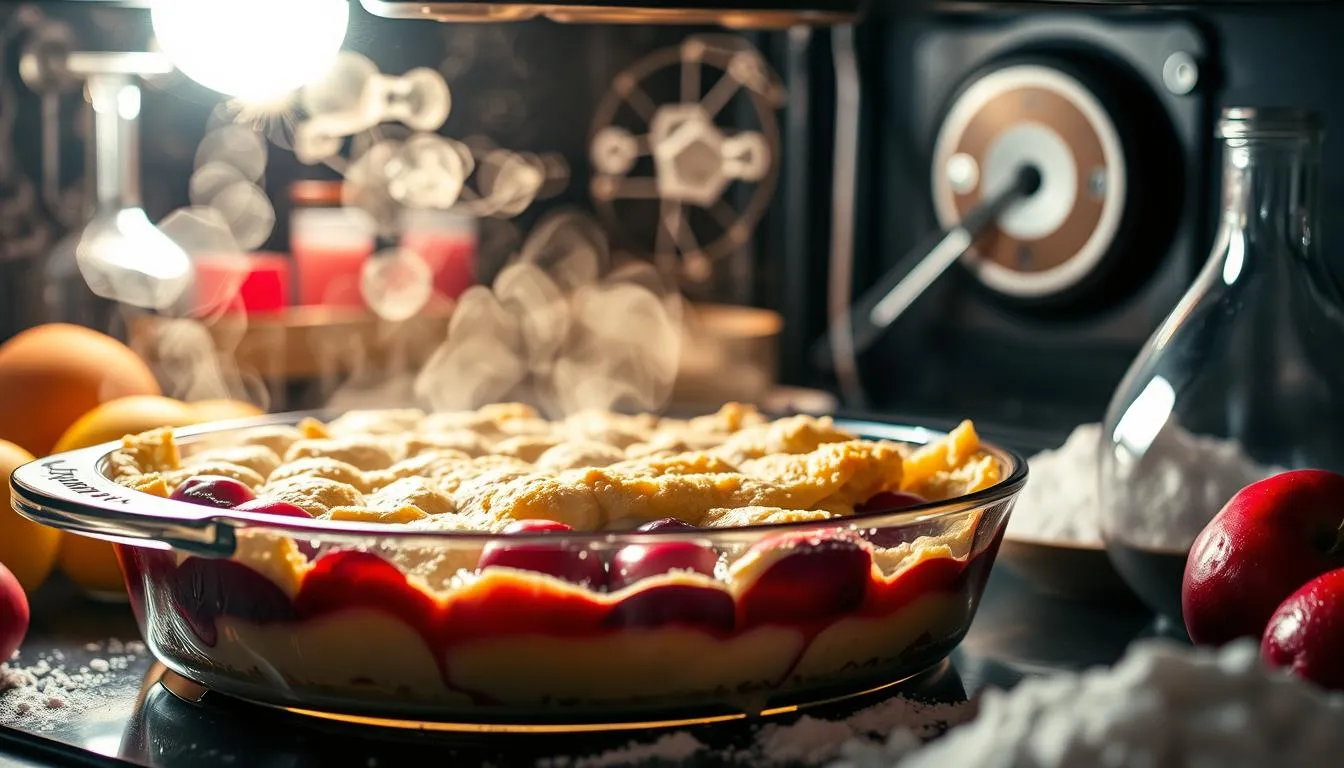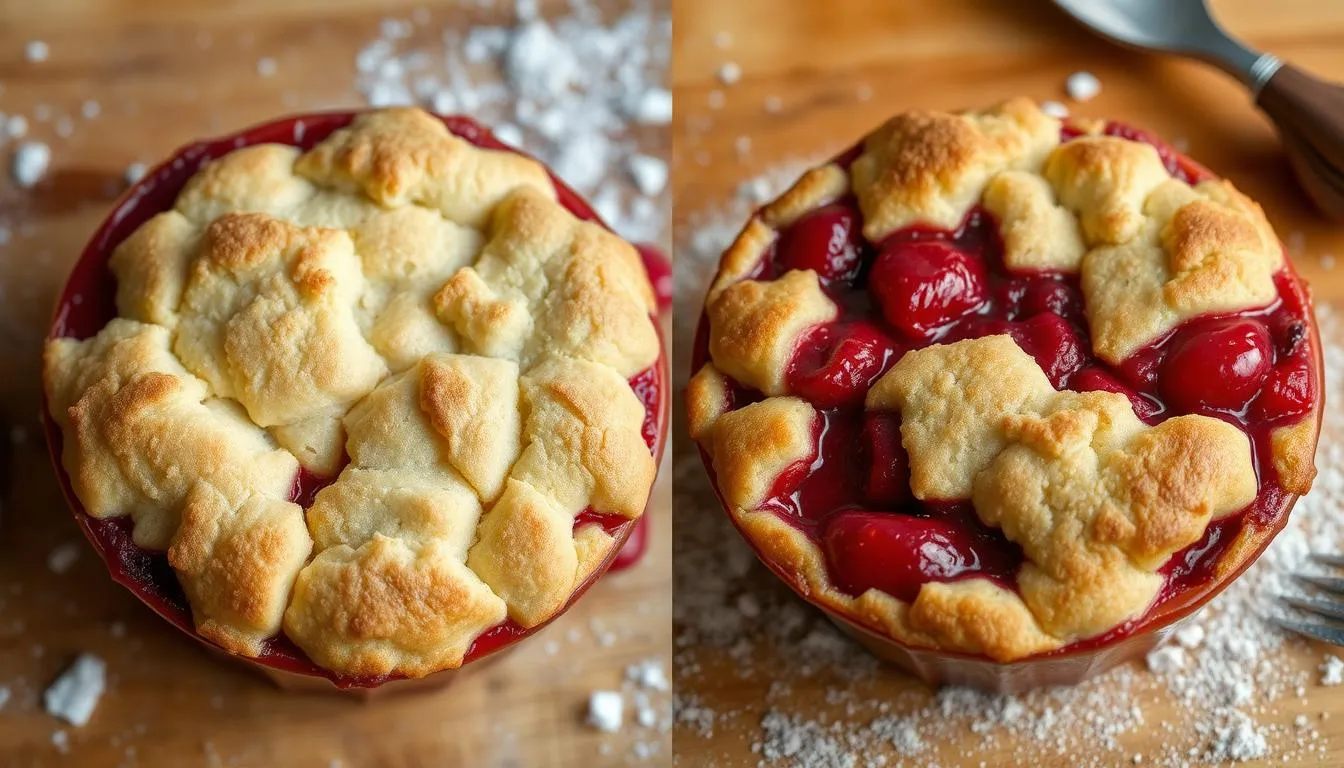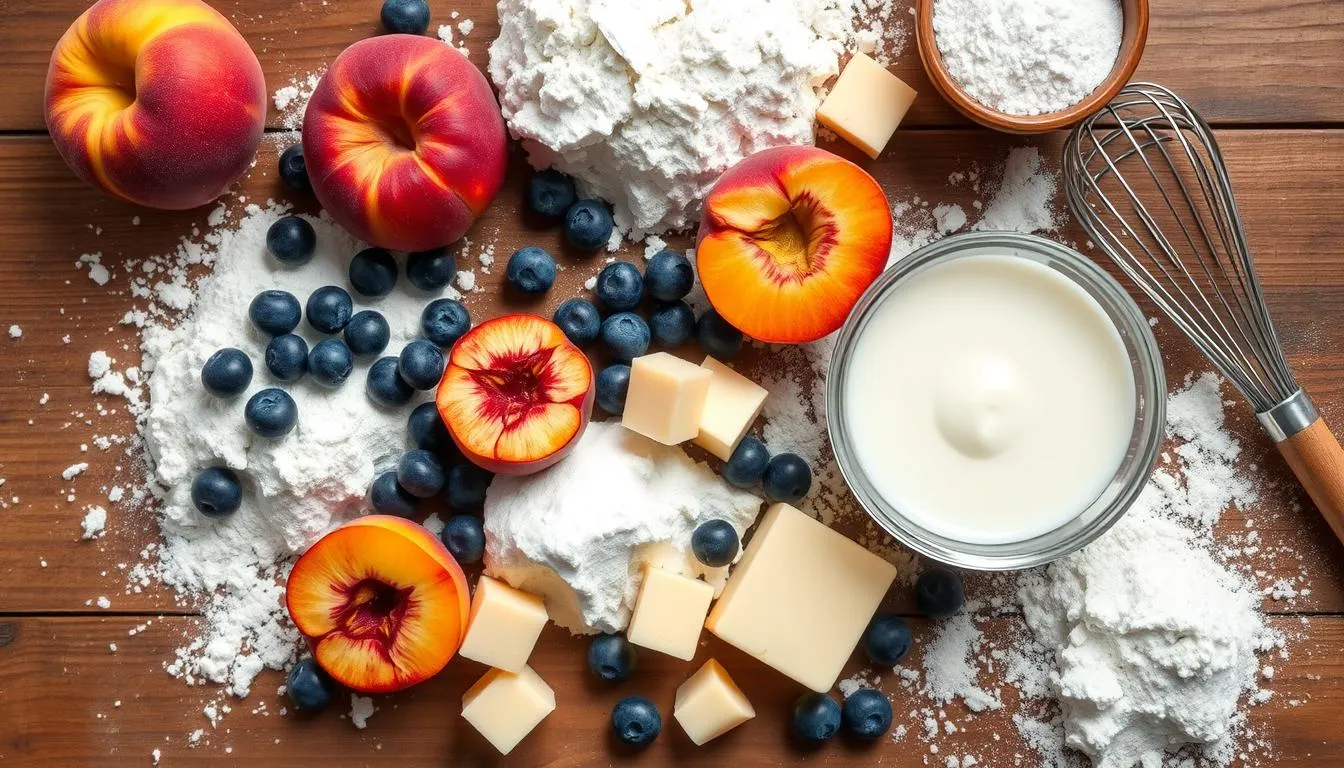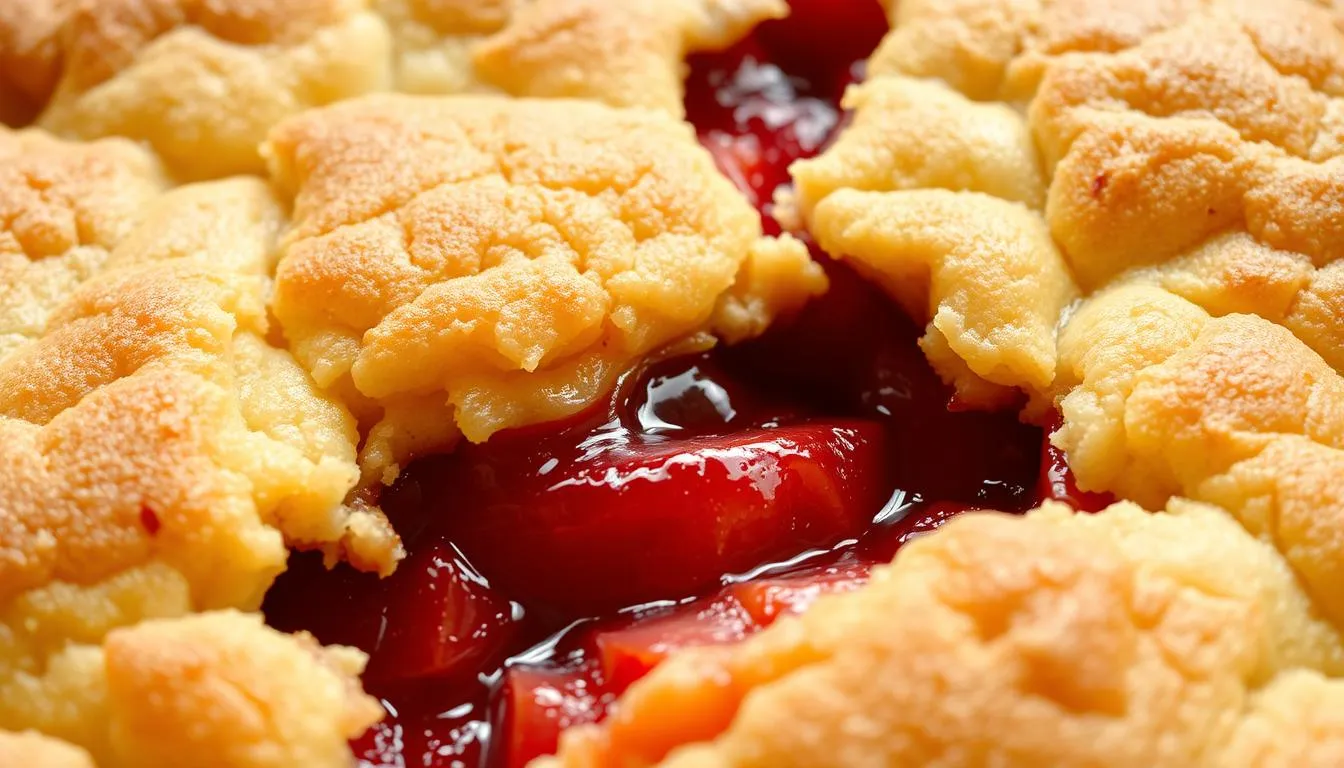Is cobbler supposed to be moist? Baking the perfect fruit cobbler is all about finding the right balance. Both home bakers and pros often wonder about the perfect moisture level. Getting the texture just right can turn a simple cobbler into a memorable treat.
The texture of a fruit cobbler is key to its appeal. Professional bakers aim for the perfect consistency to make a cobbler unforgettable. Each region in the U.S. has its own way of making this classic dessert.
Moisture in a fruit cobbler is more than just wetness. It’s about mixing the fruit filling and pastry topping just right. Skilled bakers know that the right moisture can make a simple dessert truly special.
Key Takeaways
- Cobbler texture varies by region and baking technique
- Moisture is critical for flavor and overall dessert quality
- Proper ingredient selection impacts cobbler consistency
- Baking temperature significantly influences moisture levels
- Different fruits require unique moisture management strategies
Understanding the Perfect Cobbler Texture
Cobbler consistency is an art that blends old baking ways with new ideas. Finding the perfect dessert means knowing how different places and how much moisture add to the taste.
Traditional vs Modern Cobbler Consistency
Cobbler making has changed a lot over time. Old recipes focus on a hearty crust. But today, chefs try new ways to make the crust lighter and the flavors stronger.
- Traditional cobblers have a dense, sturdy crust
- Modern ones aim for a lighter, fluffier texture
- Now, chefs mix old methods with new ingredients
“A great cobbler tells a story of its region through its unique texture and flavor.” – Pastry Chef Emma Richardson
Regional Variations in Cobbler Texture
Across the U.S., different areas have their own cobbler styles. Southern cobblers are often bigger and richer. Western ones are lighter and more adventurous.
| Region | Cobbler Characteristics | Typical Crust Style |
|---|---|---|
| Southern United States | Rich, buttery, dense texture | Thick, crumbly biscuit-like crust |
| Midwest | Balanced fruit-to-crust ratio | Slightly crisp, golden-brown topping |
| West Coast | Lighter, more experimental | Thin, crisp layers |
The Role of Moisture in Flavor Development
Moisture is key to a great cobbler. Proper moisture balance keeps the fruit juicy and the crust crisp. Chefs pick the right ingredients and baking methods to get the best taste and texture.
- Fresh fruits add natural moisture
- Thickeners help control liquid
- Right baking temperatures keep moisture in
Is cobbler supposed to be moist?
Finding the perfect cobbler texture is all about balance. It’s a mix of juicy fruit and a tender, slightly crisp top. Professional bakers say a great cobbler has this balance just right.
Cobblers need a special touch when it comes to moisture. It’s all about how you bake it to get the right feel and taste.
“A great cobbler isn’t just about sweetness—it’s about creating a perfect harmony between fruit, crust, and moisture,” says renowned pastry chef Elizabeth Harper.
- Moisture should be consistent throughout the dessert
- Fruit filling must be succulent without becoming soggy
- Topping should remain slightly crisp
- Balanced hydration is key for texture
Baking techniques are key to getting the right cobbler moisture. Several factors affect the final texture:
| Factor | Impact on Moisture |
|---|---|
| Fruit Selection | Determines natural liquid content |
| Thickening Agents | Controls excess liquid |
| Baking Temperature | Influences moisture retention |
| Resting Time | Allows filling to set properly |
The goal is not a completely dry or overly wet dessert, but a balanced, inviting texture that showcases the fruit’s natural essence.
The Science Behind Cobbler Moisture Content
Baking chemistry is key to a perfect cobbler texture. Knowing how ingredients interact and change during baking helps bakers control moisture.
Chemical Reactions During Baking
When a cobbler goes into the oven, many chemical reactions start. Flour’s starch molecules gelatinize, forming a network that holds moisture. Fruit pectin breaks down, releasing juices that add to the dessert’s moisture.
- Starch gelatinization creates structural support
- Pectin breakdown releases fruit moisture
- Protein denaturation impacts texture
Impact of Ingredients on Moisture
Ingredients greatly affect a cobbler’s moisture. They work together to achieve the right balance. This balance is between a crisp crust and a juicy filling.
| Ingredient | Moisture Impact |
|---|---|
| Cornstarch | Absorbs excess liquid |
| Butter | Creates flaky texture |
| Fresh Fruits | Provides natural moisture |
Temperature Control and Moisture Balance
Controlling oven temperature is vital for moisture control. Oven temperatures between 350-375°F are ideal. They help soften fruit without losing too much liquid.
“Baking is a delicate dance of temperature, ingredients, and timing” – Professional Baker’s Wisdom
By grasping these scientific basics, bakers can make cobblers with just the right moisture. This delightfully satisfies the taste buds and shows off their skill.
Common Texture Problems and Solutions
Troubleshooting baking challenges can make a big difference. It turns a mediocre cobbler into a magnificent one. Understanding and fixing common texture issues is key for home bakers.
- Soggy Bottom Crust: This issue often comes from too much fruit moisture or bad baking techniques.
- Dry Filling: This can happen if you pick the wrong fruit or don’t use enough sugar and thickeners.
- Uneven Baking: This is usually because of temperature problems or not mixing ingredients well.
To solve these texture problems, try these strategies:
| Problem | Solution | Technique |
|---|---|---|
| Soggy Crust | Pre-bake crust | Blind bake for 10 minutes before adding filling |
| Dry Filling | Adjust moisture | Add lemon juice or extra fruit syrup |
| Uneven Texture | Proper mixing | Gently fold ingredients to maintain even distribution |
“Perfecting cobbler texture is an art that combines science and intuition” – Professional Baker’s Insight
Professional bakers know that getting the right texture is all about precise ingredients and technique. By using these tips, you’ll make your cobbler truly special.
Key Ingredients That Affect Cobbler Moisture
Making the perfect fruit desserts means knowing how ingredients mix for the right moisture. A great cobbler comes from picking the right parts that work together for a tasty texture.
Fruit Selection and Preparation
Picking the right fruits is key for keeping cobblers moist. Each fruit gives off different amounts of liquid while baking. This affects the dessert’s feel.
- Berries: High water content, excellent for juicy cobblers
- Peaches: Natural pectin helps thicken filling
- Apples: Require additional thickening agents
Thickeners and Their Effects
Thickeners are vital for controlling moisture and avoiding soggy crusts. Cornstarch, flour, and tapioca are top picks for keeping fruit fillings stable.
“The right thickener can transform a good cobbler into an exceptional dessert.” – Professional Baker’s Tip
The Role of Butter and Fats
Fats are key ingredients that add moisture and flavor. Butter makes the crust tender and helps spread heat evenly while baking.
| Fat Type | Moisture Impact | Flavor Profile |
|---|---|---|
| Butter | Creates flaky texture | Rich, creamy taste |
| Shortening | Increases tenderness | Neutral flavor |
Achieving the Perfect Crust-to-Filling Ratio
Making the perfect cobbler is all about finding the right balance. The ratio of crust to filling is key. It makes your dessert a memorable treat for your taste buds.
“A perfect cobbler is like a harmonious symphony of textures and flavors” – Pastry Chef Elena Rodriguez
Professional bakers know that texture is everything in a great dessert. The crust-to-filling ratio is what makes or breaks your cobbler.
- Aim for a crisp, golden crust that complements the juicy fruit filling
- Ensure the crust covers approximately 60-70% of the fruit surface
- Use strategic layering techniques to maintain optimal moisture
To get the right cobbler crust, you need to pay attention to ingredients and baking methods. Here are some important things to consider:
| Crust Component | Recommended Ratio | Impact on Texture |
|---|---|---|
| Butter | 1/2 cup per 2 cups flour | Creates flakiness |
| Liquid | 1/4 cup per 2 cups flour | Ensures proper binding |
| Sugar | 2-3 tablespoons | Adds golden browning |
Pro tip: Try different flours to find your ideal crust texture. Pastry flour can give you a lighter crust than all-purpose flour.
Storage Tips to Maintain Ideal Moisture Levels
Keeping your homemade cobbler fresh is key. The right storage can turn a soggy mess into a delightful treat. It’s all about maintaining that perfect texture.
Professional bakers know the art of cooling and storing cobblers. They make sure your dessert stays as tasty as when it first came out of the oven.
Proper Cooling Methods
Cooling your cobbler right is essential. Here’s how to do it:
- Let it cool at room temperature for 30-45 minutes
- Don’t cover it right after baking
- Use a wire rack to prevent moisture buildup
Best Storage Containers
Choosing the right container is important for reheating. Pick ones that keep your cobbler moist:
- Go for airtight glass containers with loose lids
- Stay away from plastic that traps moisture
- Choose containers that let air circulate a bit
Reheating Techniques
To restore your cobbler’s texture, gentle reheating is best. Quick zaps in the microwave can ruin it. Try these instead:
- Preheat your oven to 350°F
- Cover it loosely with foil
- Heat for 10-15 minutes until warm
- Remove foil for the last 3 minutes to crisp the crust
“The secret to great cobbler is not just in the baking, but in the careful storage and reheating.” – Professional Pastry Chef
Professional Baker’s Tips for Texture Control
Getting the right texture in cobbler is all about baking skills and techniques. Experienced bakers see texture management as an art. It’s more than just following a recipe.
“Great cobbler is about precision, passion, and understanding the delicate balance of ingredients,” says Chef Maria Rodriguez, renowned pastry expert.
Professional bakers use several strategies for the perfect cobbler texture:
- Choose high-quality, fresh fruits with consistent moisture content
- Experiment with different thickening agents to control filling consistency
- Understand how temperature impacts texture management
- Practice precise measurement techniques
Starting with the right ingredients is key. Professionals suggest using cornstarch or tapioca for the filling. This helps avoid a watery cobbler and keeps it moist.
Baking expertise also means knowing your oven well. Some top techniques include:
- Preheating the baking dish to create a crisp bottom crust
- Using a light touch when mixing the topping
- Covering the cobbler with foil to prevent over-browning
Pro tip: Let your cobbler rest for 15-20 minutes after baking. This allows the filling to set and intensify flavors.
By using these professional techniques, home bakers can make their cobbler truly exceptional. They’ll master the art of texture control.
Seasonal Adjustments for Cobbler Moisture
Seasonal baking needs flexibility, more so with fruit desserts like cobblers. Each season brings its own challenges for keeping the dessert moist.
Summer and winter require different approaches to get the cobbler just right. Fresh fruits in season can make your dessert even more moist.
- Summer fruits: High water content requires careful thickening techniques
- Winter fruits: Often drier, needing additional moisture-retention strategies
- Seasonal fruit selection impacts overall cobbler consistency
Experienced bakers know that moisture management changes with the seasons. Peaches in August are different from apples in November, needing special recipe tweaks.
“The secret to perfect cobbler is understanding your ingredients’ seasonal characteristics.” – Professional Baker’s Insight
| Season | Fruit Type | Moisture Adjustment |
|---|---|---|
| Summer | Peaches, Berries | Reduce liquid, increase thickener |
| Fall | Apples, Pears | Add extra liquid, reduce thickener |
| Winter | Citrus, Dried Fruits | Incorporate fresh juice, increase butter |
To adapt recipes, you need to know each fruit’s moisture level. Try different methods to keep your cobbler moist all year.
Regional American Cobbler Styles and Textures
American cuisine is rich with regional desserts, with cobbler being a standout. It varies greatly across different areas. Each region adds its own twist to this beloved dessert.
Different parts of the United States have their own cobbler styles. These styles reflect the local culture and agriculture. From the fruit-filled orchards to the cooking traditions, each area makes its own unique cobbler.
Southern Cobbler Traditions
Southern desserts are famous for their supremely moist cobblers. Recipes from Georgia and Alabama focus on:
- Deep fruit fillings with lots of juice
- Buttery, slightly crisp top crusts
- Using seasonal fruits like peaches and blackberries
Northern Cobbler Interpretations
In the North, cobbler is made differently. It’s known for:
- More structured, cake-like bottom layers
- Less liquid-heavy fruit preparations
- Using apples and berries
Western Cobbler Styles
The West combines innovation with tradition in cobbler making. It often includes:
- Experimental fruit mixes
- Lighter, more delicate crusts
- Using local ingredients like stone fruits
“A cobbler tells a story of its region – every bite is a culinary journey.” – Chef Emily Rodriguez
| Region | Moisture Level | Typical Fruits |
|---|---|---|
| Southern | High | Peaches, Blackberries |
| Northern | Medium | Apples, Cherries |
| Western | Variable | Plums, Mixed Berries |
Conclusion
Mastering cobbler perfection is an art that combines science, technique, and passion. Every baker’s path to the ultimate cobbler involves learning about moisture control and ingredient interactions. It also means understanding personal taste preferences.
The secret to baking success with cobblers is more than just a recipe. It’s about appreciating different regional styles. From the Southern rich and moist to the Northern crisp, each style has its charm.
As you keep trying new cobbler techniques, remember that each batch is a chance to get better. Whether you like a juicy filling or a crispy topping, cobblers are incredibly versatile. Trust your instincts and enjoy the delicious results of your creativity.
Your cobbler journey is special, just like the dessert itself. With practice, patience, and a love for learning, you’ll turn simple ingredients into amazing desserts. These desserts will tell stories of tradition, innovation, and pure deliciousness.
FAQ
What is the ideal moisture level for a perfect cobbler?
A perfect cobbler should have a moist filling but not soggy. It should be juicy but firm enough to hold its shape. The filling should be soft and not watery.
How can I prevent my cobbler from becoming too dry?
Use fresh, ripe fruits to keep your cobbler moist. Add a small amount of cornstarch to control liquid. Avoid overbaking and cover with foil if needed.
Do different fruits require different moisture management?
Yes, fruits have different moisture levels. Berries are juicier, while apples and peaches might need more liquid. Adjust your recipe with cornstarch for juicy fruits and less for drier ones.
What’s the best way to store a cobbler to maintain its texture?
Store cobbler at room temperature for 1-2 days or in the fridge for up to 5 days. Use foil or plastic wrap to prevent moisture loss. Reheat in the oven at 350°F for 10-15 minutes to restore texture.
How do seasonal changes affect cobbler moisture?
Seasonal fruits change cobbler moisture. Summer fruits are juicier, needing less liquid. Winter fruits are drier, needing more. Adjust your recipe for the season and fruit type.
Can I fix a cobbler that turns out too wet or too dry?
For a wet cobbler, sprinkle cornstarch or flour over the filling and bake briefly. For a dry cobbler, add fruit juice or melted butter. Adjust your recipe for the perfect balance next time.
What’s the difference between cobbler textures in different US regions?
Cobbler textures vary by region. Southern cobblers are softer, while Western ones are crumblier. Northern cobblers are cake-like and drier.
How important is the crust-to-filling ratio in maintaining moisture?
The crust-to-filling ratio is key for moisture. A thick crust can absorb too much, while a thin one might be soggy. Aim for a 60/40 filling-to-crust ratio for the best moisture balance.





